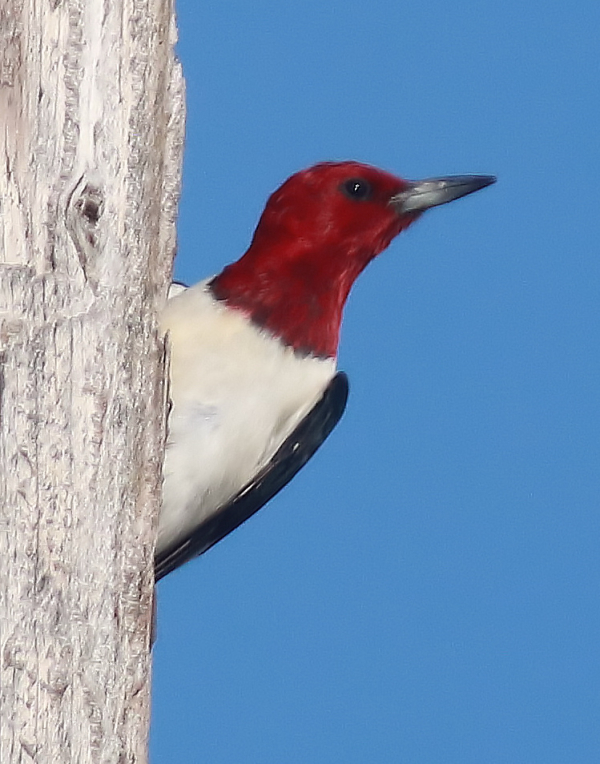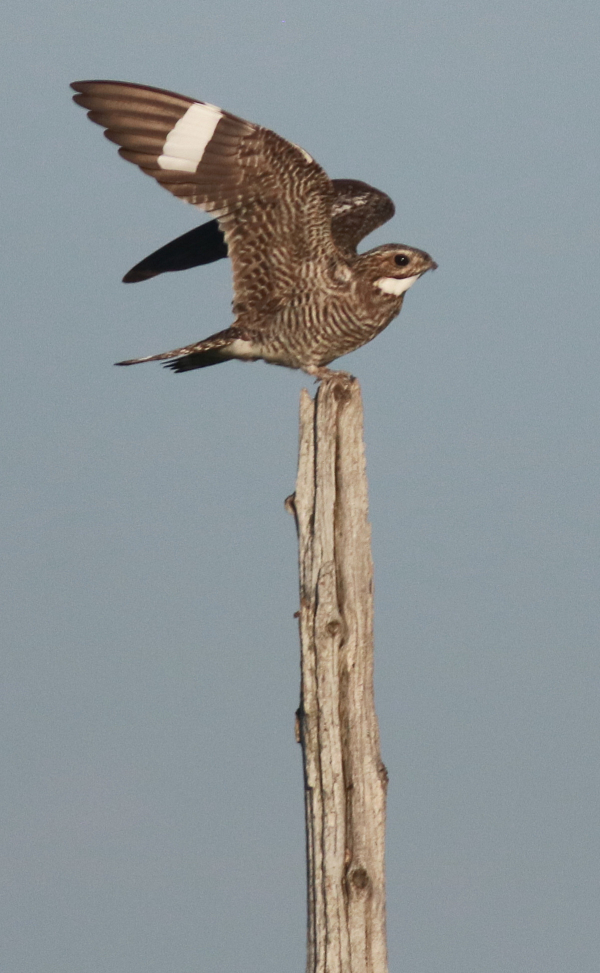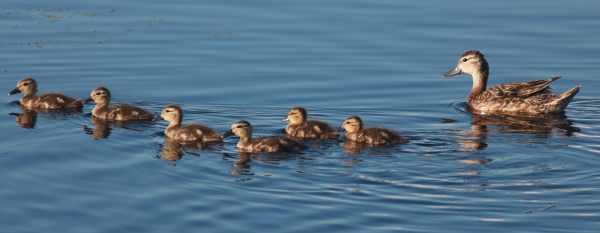
The return of Red-headed Woodpeckers to two nesting territories used last year is exciting, and finding this year’s nesting cavities was a highlight of the week.

The length of the wings of a Common Nighthawk is surprising when compared to its small body size. This nighthawk actually overshot the perch and had to flutter a moment to gain its stance atop the pole.

The Lost Road prairie is a nighthawk stronghold during summer, as it is for Upland Sandpipers, Western Meadowlarks, Eastern Kingbirds, Clay-colored Sparrows, Wilson’s Snipe – and this year, Dickcissels.

Blue-winged Teal provide weekly photo opportunities as new broods hatch during this peak brood rearing period.
|
On a windless evening I enjoyed the avian delights of the open northern prairie, then dropped down off the Coteau onto the open agricultural plains, moving from the past to the present in many ways. My destination was the Bald Eagle nest I have monitored this year and last, presumably by the same pioneering pair that fledged three eagles last year. Now there were two fully feathered nestlings ready to fledge – the young male standing on the nest and the comparatively huge female standing a few feet away on one of the large branches that cradled the grand nest, with one adult perched 20 feet above the nest.
It was obvious the two nestlings will soon take the plunge, so to speak; but after leaving the nest, they will use the site as a central gathering point, especially because the adults will continue to bring food there as they learn to fly and hunt on their own – during the extended post-fledging period. I’ll keep you posted on their progress.
Perhaps even more exciting, while I checked on the eagles, two Red-headed Woodpeckers were actively catching large insects along the road. One of the Red-heads flew to a big snag, all that’s left by a long dead cottonwood tree of which only the bottom 18 feet of barkless trunk remains. I lost sight of the woodpecker in the shade, but saw it working its way up the back of the trunk, then perch atop the snag for a couple minutes. During its second return to the snag, the Red-head entered a fairly obvious cavity with an insect, then slipped back out and returned to the hunt. Hooray! The beautiful woodpecker not only showed me its nesting cavity, but also indicated it has small nestlings it is feeding inside the cavity – very exciting!
I hoped to learn where the other Red-headed Woodpeckers I was monitoring were nesting too, and that was my nest stop, about 3 miles distant. There, I quickly sighted the resident Red-head, and like the others, it was hunting large insects from wooden poles along the road. The first trip the woodpecker made to the nest site with food permitted me to zero in on the location, so during the second return I was able to see it perch outside the entrance to the nesting cavity, presumably to pass food to its still incubating mate judging from the behavior.
I was a bit surprised by the location, but probably shouldn’t have been. Last year, as the male of the pair that occupied this territory (probably the same pair?) hunted for and fed the incubating female, he found time to excavate a new cavity in a large tree about 200 feet to the east of their nesting cavity. I wondered then if it was excavating a new cavity for a second nesting attempt, or possibly as an option for fledglings or adults to roost at during the post-fledging period. However, it seemed as though the new cavity was abandoned, considering that I never saw a woodpecker use it after it appeared to have been finished. Now, the resident pair is using just that cavity, which provides a much better view of the birds. While they continue this year’s nesting activities, I certainly look forward to monitoring their progress, and sharing my observations with you all.
Backyard Update
Since mid-June, catbirds and robins have dominated my feeding station, primarily making ever more frequent stops at the jelly feeder. Almost as common visitors, Baltimore and Orchard Orioles favored the jelly feeder, but male Baltimore Orioles dominated the nectar feeder throughout the period. As of Saturday, however, that order switched when Orchard and Baltimore Orioles resumed the mantle of the most common feeding station visitors, by far. It was especially interesting that one or more fledgling Orchard Orioles fed on jelly, and during one visit, a young Orchard also fed on nectar.
During June, there appeared to be 2 male and 1 female Baltimore Oriole, and 1 male Orchard Oriole using my feeding station, but that began to change early last week. On Tuesday, a female Orchard Oriole seemed to arrive with a male Baltimore Oriole. The Baltimore hopped on the nectar feeder while the female Orchard Oriole, the first to visit the feeding station this year, fed on grape jelly. An hour or so later, the usual female Baltimore Oriole arrived, followed by a another yearling female – what fun. At the end of the week, a fledgling Baltimore Oriole perched on the nectar feeder and tasted the jelly before leaving – now we’re getting serious.
Friday, I was surprised when two adult male Orchard Orioles arrived simultaneously. This action was repeated Saturday and Sunday, suggesting 2 for sure, but probably indicating there were at least 3 adult male Orchards considering 2 seemed to be traveling together. And to top off July 4th, after a couple of weeks without a hummingbird sighting, I caught spotted a little female perched at the nectar feeder for a moment.
On the 4th of July I decided to re-installed my suet feeder, hoping to get better looks at a dark-colored female Hairy Woodpecker that occasionally lands on the trunk of the ash tree adjacent to my feeding station, I had taken the suet down in May out of desperation to stop the onslaught of flocks of starlings and grackles. With a minimum of both species in the neighborhood now, I thought I’d give it a try, especially considering the visit of the interesting Hairy Woodpecker and the call of a nuthatch the day before. Then too, maybe the no-melt hot pepper suet, which repels squirrels, will attract some new avian action.
It did – Sunday morning House Sparrows had engulfed the suet cage, and the frenzied commotion made me remove the suet when I refreshed the nectar, grape jelly, and orange slices at my feeding station. The sparrows quickly dispersed and my feeding station returned to the July “normal.” But 25 minutes later, the dark-colored female Hairy Woodpecker landed next to the location where the no-melt suet was hanging – “shucks!” She looked and looked, as if in disbelief that the suet was missing, then flew off. Obviously, I quickly returned the suet, and a half-hour later, there she was! I was thrilled to get a better look at her, but in the blink of an eye, a begging male fledgling flew in! WoW! Now I was excited, and as the female fed the fledgling suet bits time and time again, it was heart-warming to see the interactions so near.
The fledgling was beautiful in its new plumage and almost it eventually flew to the suet feeder to cling there a moment before returning to an adjacent perch to be fed by the female. After a couple feeding interactions, the fledgling flew to the adjacent trunk of the ash tree, where the female fed it a couple more times, then the fledgling flew to the northwest. The female returned to the feeder, grabbed some suet, and flew to the east. She returned periodically, swallowing some suet, then taking a piece with her as she flew off in a different direction each time. Her differing flight paths made me wonder how many fledglings she had in the neighborhood. In fact, she may still have a couple nestlings to feed. Nonetheless, that suet move sure paid off quickly!
After more than an hour hiatus, the female Hairy returned, perched next to the suet feeder, and called for a moment – until a fledgling flew in, begging even before it landed. Then a second male fledgling flew in, but was promptly chased to the ash tree by the first. The female fed the more aggressive fledgling – the new one – a couple times while it chased the other fledgling between feeding bouts. All woodpeckers left after a few minutes, but the more aggressive fledgling returned 10 minutes later and fed for an extended period, clinging to the suet cage like an expert.
The threesome returned about an hour later, but while the aggressive fledgling chased the other male once, thereafter it fed at the suet cage while the female fed fledgling the other. What fun! I’m guessing the darker than usual coloration of the female Hairy Woodpecker is the result of spending an extended period in the nesting cavity. It appears the female’s white plumage is dulled to gray, which gives her a darker appearance overall. I’ll let you know how things progress as these dynamic new stars of my bay windows continue to visit.
Mas Patos!
For your Spanish lesson today, the word for ducks is patos. That was easy, so let’s try one more word: The Spanish word for ducklings is patitos (I love that word). Lately there have been mucho patos and patitos, and the trend continues. Throughout June there has been a wonderful succession broods of “puddle ducks” appearing daily, including abundant Blue-winged Teal, many Mallards, Northern Shovelers, a few Northern Pintails and Wood Ducks, an American Wigeon brood (rare here), and the first Gadwall broods. Gadwall broods should really begin appearing in numbers during July, along with many more Blue-winged Teal, Mallards, and shovelers.
The only “diving duck” broods I’ve seen to date have been the 3 Canvasback broods. There are still many broods to hatch, with nests already being incubated by a host of Redheads and Lesser Scaup, along with some Ring-necked Ducks, and hopefully more Canvasbacks. Ruddy Duck broods will probably be much more abundant than normal, and I spied the first “early” Ruddy brood July 4th.
Week 9 at McKenzie was similar to the previous week, but with duck broods spread out more, limiting photography. I managed a few photos of new broods of Mallards and Blue-winged Teal, and older Northern Shoveler ducklings. At a productive wetland between McKenzie and Bismarck, I happened upon a new brood of Northern Shovelers with an especially trusting female, creating a special opportunity to photograph her and her ducklings during a couple photo visits. I describe that action in this week’s Bird Photography article, which you can refer to at the bottom of this week’s issue of The Birding Wire.
I want to mention two other exceptional birds I observed last Wednesday. First, an early Ferruginous Hawk fledgling perched on a hay bale 120 feet north of the second Ferrug nest that I have been monitoring, which is located about 25 miles west of my office. At McKenzie Slough, I pied a species I rarely get to see – a Virginia Rail, crouched in rail fashion on the edge of the road, although as I viewed it, the rail sounded a low repeated call that I hoped would entice some downy hatchlings out of the vegetation. But alas, a car passed by, the rail slipped into the foliage, and I continued on my way.
Shorebird Prediction
July 4th was a work day for me – I work weekends and take a couple mid-week days off instead, and the weather was forecast to be “iffy” anyway. Small showers broke up the sunshine a couple times, until about 4:30, when the real fireworks began – nature’s fireworks. It began with lots of thunder and crashes of lightning, and it poured(!!!) for 95 minutes, which was long enough to almost fill my rain gauge and cover much of the surrounding land with a sheet of water.
I have never seen so much standing water in this area before. As I took a short reconnaissance drive, I imagined that flocks of Arctic-nesting sandpipers will soon begin migrating into the area, and if there are some remnant mudflats that Saturday’s 4 inches of rain produced, there could be an outstanding stopover period for shorebirds coming up. The high water levels this spring really nixed stops by most shorebirds migrating to the Arctic, but shallow water areas such as they stand now would be mighty attractive to the same birds I predict. I’ll let you know how that goes – and I’ll skip the Spanish word for sandpipers (lavenderas, roll the “r”). In the meantime, the ducks and gulls will surely have some new feeding areas.
Hope you enjoyed a super holiday weekend with some birding mixed in somehow, someway. With the nesting season still in full swing, and the brood rearing and fledging periods progressing too, I certainly hope you enjoy the birds around you – in your yard and in the field.
Article and photos by Pablo Konrad
Share your bird sightings and photos at editorstbw2@gmail.com